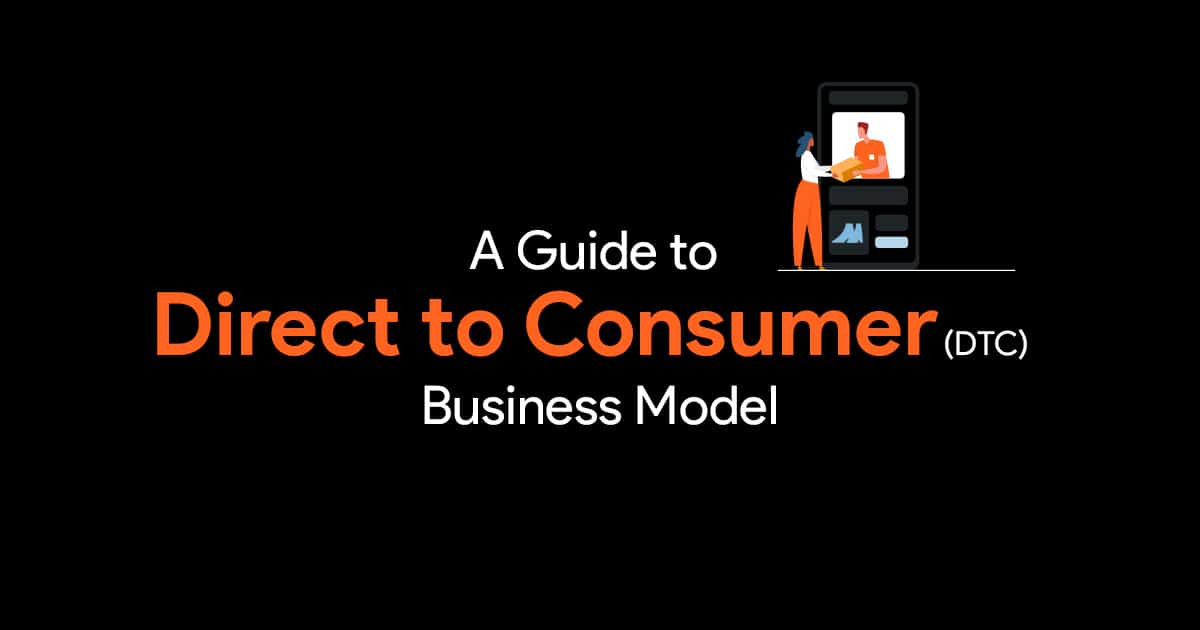A Guide to Direct-to-Consumer (DTC) Business Model

The direct-to-consumer business model is bustling, and you need to consider joining the bandwagon seriously. It is expected that over 65% of consumers will have a direct connection with businesses and that this DTC model already makes up 40% of the growth in the sales of packaged consumer goods. So, the DTC model is in for the long haul and will continue to grow for some time.
What is DTC?
Let’s first get a clear understanding of what DTC is. A direct-to-consumer company directly sells its products to consumers, eliminating middle channels like retailers and distributors. Doing this enables the business to sell its products at lower prices and maintain control over marketing, distributing the products, and even producing them. It also takes away the tension of competition at the point of sale. The DTC model is flexible in that it allows brands to connect with their target audience in different methods like:
- Direct shipping of products to customers
- Popup model
- Partnerships with select retailers.
- Launching flagship storefronts
In fact, everything but traditional retailers!
Try out ready made business model PPT templates that you can use in your presentations Check out our other business models like franchise business model.
How is DTC different from B2C?
All DTC brands are B2C, but all B2C businesses are not DTC. A B2C company need not be the manufacturer of the products they sell. A DTC business sells products it manufactures directly to the customer. That is the main difference between the two.
A DTC business identifies the problems of conventional retail business and takes proactive measures; they disrupt business with innovative models of direct selling.
Why DTC is Here to Stay
Let’s look at some statistics to understand this. As per various studies and surveys, 40% of the respondents believed they would make more than half their purchases from DTC companies. One survey showed that over 60% of businesses have already adopted a direct-to-consumer business model as part of their overarching business strategy. They believe this model benefits both manufacturers and consumers. For example, Nike made profits of over 15 million dollars by 2020-2021 in the DTC arena.
So, what is pushing this trend? Why is this preference for this particular business model? Of course, each business has its unique reasons, but three important factors are causing the swing:
Shrinking margins from multichannel retail
Intense competition and the emergence of large online retailers have made huge dents in the sales of brick-and-mortar stores. This has led to them downsizing their product portfolio and lowering the margins of the products they sell.
Altered consumer expectations
Today’s consumer is tech-savvy, discerning, and has little patience. They want to be able to purchase a product from the site they see it and read about, rather than going to a third-party retailer site from the manufacturing company website. Thanks to this, entrepreneurs now integrate tech and consumer goods, creating native brands that generate revenues.
Technological advancements
With the arrival of cloud computing, it became easy to procure products, accept customer orders and take care of order fulfillment from anywhere; it was no longer necessary to be at the workplace or store. This phenomenon spurred entrepreneurs to create their own DTC stores and product lines.
Both startups and established businesses are increasingly moving towards the direct-to-consumer business model.
Leading DTC Brands
Let’s look at some of the names that have made it big in this niche:
Glossier – this is a cosmetics company that is now valued at over 1.2 billion USD
Warby Parker – an eyeglass retailer valued at around 1.7 billion USD
Chewy – a pet supplies retailer, earned over 11 billion last year
Fitbit – fitness wearables company
OpenSea – NFT marketplace that reported over 144 million USD in revenue in the third quarter of 2022
The Benefits of Direct-to-Consumer E-commerce
Let’s now see what benefits the direct-to-consumer models of business offer.
Data Ownership
DTC firms have complete ownership over the data in CRM, sales, etc., as they sell directly to the consumers, which gives them an edge. They can:
- leverage that data however they want and use those insights to craft strategies for the future.
- can perform better purchase trend analysis.
- can use customer demographics data to deliver personalized marketing messages.
DTC companies can get a lot of insight from the data on searches made by customers on their sites regarding customer preferences.
Shorter supply chain
With the retailer out of the picture, the supply chain becomes a little shorter, enabling DTC businesses to exercise more control over the buyer journey – from acquiring customers to retaining them and building brand loyalty.
Quicker and cheaper Go-To-Market
Conventional CPG companies invest significant amounts of money to get their product to market. It can even take months to get one single product to market. DTC companies however, can have small scale releases, targeting a niche audience.
Product Personalization
DTC startups can create personalized products that consumers find attractive if they have complete control over the sales of their products.
Branding control
Branding guidelines bind retail stores, but this doesn’t apply to DTC businesses. They can craft their strategies to attract customers as they are responsible for their marketing strategy and sales.
Digital edge
DTC brands take advantage of digital advertising and influencer marketing, as these methods target the end user and are very effective. This gives DTC companies better returns and higher profits.
Subscription-based pricing
Subscription-based pricing is the most popular pricing model today. As it provides a steady revenue stream, DTC brands prefer to implement it. This model also helps to retain customers – a vital element of success for direct-to-consumer companies.
Higher margins
Manufacturers don’t have full control over pricing when retailers are involved or when the competition is heavy. This prevents them from selling higher-end or exclusive products in the way they want. This problem is eliminated in the DTC model, where brands can sell niche items directly to consumers. For example, some companies sell a few of their products at retail stores but keep the premium products for direct sale through the website.
Enhanced customer experience
Consumers have become more discerning than ever, and DTC brands are well-positioned to deliver outstanding customer experiences, thanks to their greater control over their products, marketing, and pricing. Conventional manufacturers have little say in how or where their products are displayed in retail stores and other websites, how customer inquiries are responded to, or how the product is delivered. In DTC models, all of this is in the manufacturer’s hands, and they can easily deliver the brand experience they want.
How Can You Get into the DTC Business
We learned what a DTC startup is. So how do you run a DTC startup? Here is what you need to know:
Understand Your Market and Target Audience
Understanding your market and target audience is critical when you market your products directly to your customers. First, determine the problems or pain points your product solves, who needs them, and how your product compares to similar products in the market. Once you know this, you must find the best way to market your product to your audience. The most commonly used methods are personalization, influencers, and user-generated content.
Start With One Product
Diversity may not be your best friend in the DTC model, especially at the outset. Please keep it simple; one product category or even a single product to start with. Make sure it resonates with your audience, and do your best to be the best in that niche – to be seen as the expert in it.
Data-driven Decision
Data is your most crucial asset; having complete or most ownership over your sales and customer data helps you make more accurate and reliable decisions regarding the product, its pricing, its marketing strategy, and more. You can get valuable insights by analyzing data and KPIs related to website browsing and other aspects of consumer behavior.
Create Personalized Marketing and Great Customer Experience
You can build brand loyalty by delivering seamless, hassle-free, and engaging customer experiences. Smooth and quick processes for searching and check-out can motivate consumers to purchase your products.
Enhance your DTC Strategy
We’ve seen how you can start your direct-to-consumer business. Here are some tips to improve your strategy:
Build Your Brand Identity
You need to build a robust brand identity that helps consumers recognize and acknowledge your products and ensure that it is relayed across all your channels. New products online won’t be easily trusted by customers, and you cannot launch your products through retail stores as a DTC company! However, several methods exist that will help you build this identity, allowing consumers to recognize your products immediately.
Collect and Analyze Marketing Data
We’ve already stressed the importance of data collection and analysis directly from your customers. However, cookies disappear, and you must make strong relationships with digital marketing platforms to collect the maximum possible data about marketing activities. While you may not be able to glean customer identity, even generalized data can reveal a lot if you leverage appropriate marketing KPI software.
Be Authentic
Branding is vital everywhere, but in DTC, it’s the most important thing. If you promise something to your customers, you must go through with it and work towards your mission and vision.
Leverage Social Media
Social media can be your most potent weapon to grow your brand. It is your own space where you can share information about your products and be persuasive to a wide audience. It lets you engage closely with customers, which is critical as you wouldn’t meet them in person otherwise. You can get feedback on improving your current products and ideas to create new ones. When customers share your posts, your brand gets endorsed and becomes visible.
Enlist Influencers
The influencer marketing value is set to touch $24 billion by 2025; they are more effective at promoting products with their opinions than big celebrities who are roped in for paid ads. So find influencers who share your values, and watch your audience and brand grow.
Use Email Marketing
DTC brands depend on digital channels but verifying social media data can be dicey, as can conveying your message through their platforms. Email marketing is something that helps you reach customers directly and can have complete control over. You can also collect specific data on your marketing KPIs that can inform future campaigns.
Retarget Customers
About 70% of shopping carts are abandoned online – how frustrating! So near to closing a sale, and yet so far. You can follow your customers online through retargeting, reminding them of the products they left behind in their carts. Then, you can coax them to return and complete the checkout by giving them some extra incentives like a freebie or discount.
Build Customer Loyalty
Returning customers tend to spend more than new ones; retaining customers is far less expensive than acquiring new ones. You must concentrate on customer retention and building loyalty to grow your business. Personalization, loyalty programs, and upselling are some ways to do this. Implement marketing tech required to gather and analyze quality data from customers, and leverage that data to deliver brand outreach in ways they prefer.
Offline Marketing
It’s true that direct-to-consumer businesses flourish online; however, you need to draw in customers who are not yet digital to grow your brand truly. Use offline marketing like banners, flyers, and posters to spread awareness about your products. Measuring these methods’ impact is a bit tough, but you still need to do it.
Final Thoughts
The fact that newer brands are entering the DTC arena and doing well is enough for you to get on to the bandwagon. The direct-to-consumer business model is here to stay and offers a win-win for brands and consumers. As a business, you can connect meaningfully with your audience and have greater control over the entire buyer journey.


